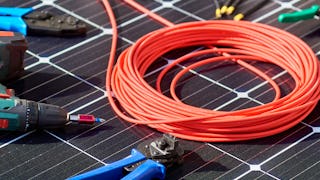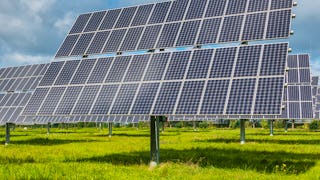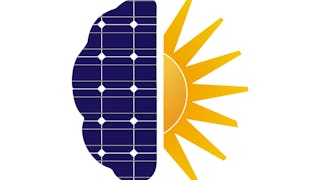Die Auslegung von Solarenergiesystemen baut auf der Einführung in PV-Systeme aus dem Kurs Solarenergie-Grundlagen auf, in dem die grundlegenden Systemkomponenten und -funktionen sowie einige grundlegende Systemdimensionierungen anhand vereinfachender Annahmen behandelt wurden. Sie sollten zu diesem Zeitpunkt über ein grundlegendes Verständnis von elektrischer Leistung und Energie verfügen und in der Lage sein, den Energiebedarf eines Standorts sowie das Energieerzeugungspotenzial einer PV-Anlage an einem bestimmten Standort unter optimalen Bedingungen zu berechnen. Ein großer Teil dieses Kurses wird sich auf die Einbeziehung der Bodenbedingungen in die Überlegungen zur Energieerzeugung konzentrieren und darauf, wie diese Bedingungen bei der Systemauslegung und der Auswahl der Geräte berücksichtigt werden können. Am Ende dieses Kurses sollten Sie in der Lage sein, Verluste bei der Bestrahlungsstärke zu berücksichtigen, die durch eine nicht optimale Positionierung und/oder Abschattung der Module entstehen, und Schwankungen bei der Modulleistung aufgrund von Temperaturschwankungen in Ihrem Systemdesign zu berücksichtigen.



(448 Bewertungen)
Empfohlene Erfahrung
Wichtige Details

Zu Ihrem LinkedIn-Profil hinzufügen
17 Aufgaben
Erfahren Sie, wie Mitarbeiter führender Unternehmen gefragte Kompetenzen erwerben.


Erwerben Sie ein Karrierezertifikat.
Fügen Sie diese Qualifikation zur Ihrem LinkedIn-Profil oder Ihrem Lebenslauf hinzu.
Teilen Sie es in den sozialen Medien und in Ihrer Leistungsbeurteilung.

In diesem Kurs gibt es 5 Module
Willkommen zum ersten Modul von Solar Energy System Design. In diesem Modul werden Sie sich etwas eingehender mit der Ressource Sonne beschäftigen als im Kurs Grundlagen der Solarenergie. Dabei werden Sie sich einige Eigenschaften des Sonnenlichts genauer ansehen und erfahren, was mit dem Licht auf seinem Weg von der Sonne bis zur Erdoberfläche geschieht.
Das ist alles enthalten
8 Videos1 Lektüre4 Aufgaben
Wir werden uns nun die Schaltkreise und elektrischen Eigenschaften von Modulen und Arrays genauer ansehen. In Solarenergie-Grundlagen haben Sie anhand von Modulspezifikationen die Leistung anhand von Spannung und Stromstärke berechnet. In diesem Modul werden Sie diese Modulspezifikationen erneut verwenden und sich ansehen, wie wichtig die verschiedenen Spannungs- und Stromwerte sind, um zu bestimmen, wie das Modul unter verschiedenen Bedingungen funktioniert. Schließlich werden wir uns mit dem Aufbau der internen Schaltkreise von Modulen und der Schaltkreise von Arrays von Modulen befassen.
Das ist alles enthalten
5 Videos1 Lektüre3 Aufgaben
In Solarenergie-Grundlagen haben Sie die Größe und die Leistung von Photovoltaikanlagen auf der Grundlage der verfügbaren Sonneneinstrahlung berechnet. Diese Sonneneinstrahlungswerte basierten immer auf der Annahme, dass die Anlage unter optimalen Bedingungen errichtet wurde. Die Bedingungen vor Ort können oft zu Abweichungen von der optimalen Auslegung für die Erfassung der gesamten verfügbaren Sonneneinstrahlung führen, z. B. wenn der Winkel eines Daches und die Ausrichtung festgelegt sind oder wenn nahe gelegene Bäume einen Teil der Anlage verschatten. In diesem Modul lernen Sie, wie Sie die verschiedenen Quellen von Sonneneinstrahlungsverlusten berücksichtigen können, da sich die Gesamtproduktivität eines Systemdesigns je nach Positionierung der Anlage, Temperaturschwankungen und Abschattung von Teilen der Anlage ändern kann. Diese Schwankungen in der Produktivität müssen bereits in der Planungsphase einer PV-Anlage berücksichtigt werden.
Das ist alles enthalten
7 Videos2 Lektüren6 Aufgaben
Im letzten Inhaltsmodul des Kurses werden Sie sich mit der Auswahl der Geräte und der Dimensionierung des Systems befassen. Die vorangegangenen Module zu den Themen Standortwahl, Einstrahlungsschwankungen, Temperatureinflüsse, Abschattungsverluste und Schaltungsdesign werden bei der Planung eines Systems eine Rolle spielen. Darüber hinaus werden Sie sich mit der Vermessung des Standorts befassen, bei der diese Informationen gesammelt werden, und mit der Genehmigung, bei der sie aufgezeichnet und zusammen mit dem empfohlenen Systementwurf mitgeteilt werden.
Das ist alles enthalten
5 Videos2 Lektüren4 Aufgaben
Im Abschlussprojekt dieses Kurses werden Sie vieles von dem anwenden, was Sie in diesem Kurs gelernt haben. Sie müssen eine PV-Anlage mit handelsüblichen Komponenten entwerfen und deren Leistung unter standortspezifischen Bedingungen berechnen. Dabei müssen Sie die verfügbare Sonneneinstrahlung und die Verluste durch die Positionierung der Anlage sowie durch Abschattung berücksichtigen. Außerdem müssen Sie eine optimale Konfiguration für die Verbindung der PV-Module mit einem Wechselrichter entwerfen. Schließlich werden Sie das Design eines PV-Systems auf Genauigkeit und Sicherheit prüfen.
Das ist alles enthalten
1 peer review
Dozent

Mehr von Elektroingenieurwesen entdecken


University at Buffalo


University at Buffalo


The State University of New York


Technical University of Denmark (DTU)
Warum entscheiden sich Menschen für Coursera für ihre Karriere?




Bewertungen von Lernenden
448 Bewertungen
- 5 stars
81,25 %
- 4 stars
15,17 %
- 3 stars
1,11 %
- 2 stars
0 %
- 1 star
2,45 %
Zeigt 3 von 448 an
Geprüft am 10. Nov. 2022
over all a very good course for solar design and PV array sizing .. Need a little more time for the Equipment sizing and selction section and also the state wise permits and NOC.
Geprüft am 11. Sep. 2022
Loved this course. With a very practical perspective, it does not go deep into PV theory but focusses more on what you should know to design your own PV System. Overall I am very satisfied!
Geprüft am 27. Dez. 2020
this is a course to where you design and spec a PV system, it is well presented and i have learnt many new things . a big thanks to prof Neal Abrams

Neue Karrieremöglichkeiten mit Coursera Plus
Unbegrenzter Zugang zu 10,000+ Weltklasse-Kursen, praktischen Projekten und berufsqualifizierenden Zertifikatsprogrammen - alles in Ihrem Abonnement enthalten
Bringen Sie Ihre Karriere mit einem Online-Abschluss voran.
Erwerben Sie einen Abschluss von erstklassigen Universitäten – 100 % online
Schließen Sie sich mehr als 3.400 Unternehmen in aller Welt an, die sich für Coursera for Business entschieden haben.
Schulen Sie Ihre Mitarbeiter*innen, um sich in der digitalen Wirtschaft zu behaupten.
Häufig gestellte Fragen
Der Zugang zu Vorlesungen und Aufgaben hängt von der Art Ihrer Einschreibung ab. Wenn Sie einen Kurs im Prüfungsmodus belegen, können Sie die meisten Kursmaterialien kostenlos einsehen. Um auf benotete Aufgaben zuzugreifen und ein Zertifikat zu erwerben, müssen Sie die Zertifikatserfahrung während oder nach Ihrer Prüfung erwerben. Wenn Sie die Prüfungsoption nicht sehen:
Der Kurs bietet möglicherweise keine Prüfungsoption. Sie können stattdessen eine kostenlose Testversion ausprobieren oder finanzielle Unterstützung beantragen.
Der Kurs bietet möglicherweise stattdessen die Option 'Vollständiger Kurs, kein Zertifikat'. Mit dieser Option können Sie alle Kursmaterialien einsehen, die erforderlichen Bewertungen abgeben und eine Abschlussnote erhalten. Dies bedeutet auch, dass Sie kein Zertifikat erwerben können.
Wenn Sie sich für den Kurs einschreiben, erhalten Sie Zugang zu allen Kursen der Specializations, und Sie erhalten ein Zertifikat, wenn Sie die Arbeit abgeschlossen haben. Ihr elektronisches Zertifikat wird Ihrer Erfolgsseite hinzugefügt - von dort aus können Sie Ihr Zertifikat ausdrucken oder zu Ihrem LinkedIn-Profil hinzufügen. Wenn Sie die Kursinhalte nur lesen und ansehen möchten, können Sie den Kurs kostenlos besuchen.
Wenn Sie ein Abonnement abgeschlossen haben, erhalten Sie eine kostenlose 7-tägige Testphase, in der Sie kostenlos kündigen können. Danach gewähren wir keine Rückerstattung, aber Sie können Ihr Abonnement jederzeit kündigen. Siehe unsere vollständigen Rückerstattungsbedingungen.
Weitere Fragen
Finanzielle Unterstützung verfügbar,
 enthalten
enthalten
